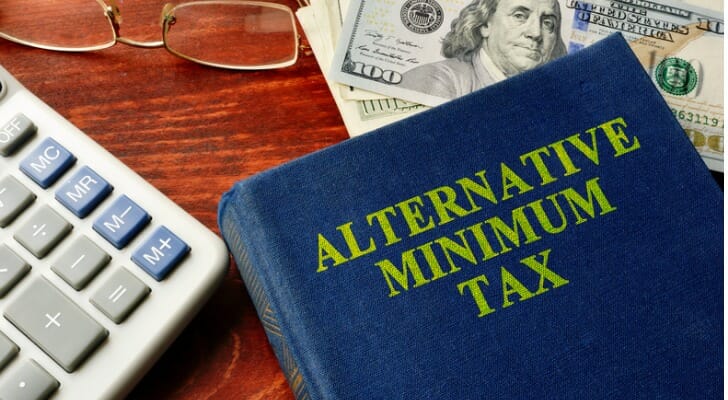The CARES Act brings financial relief to small businesses that are struggling financially amid the COVID-19 outbreak. Some of the relief measures introduced include expanded SBA lending options and special tax breaks to reduce business owners’ tax liability. One such measure makes temporary modifications to the guidelines of the Alternative Minimum Tax (AMT). If your business was previously subject to this tax, here’s what you need to know about the CARES Act provisions for the AMT and what they mean for you.
Alternative Minimum Tax, Explained
The alternative minimum tax (AMT) can be used in place of the regular income tax to determine how much tax someone owes. The tax was designed to prevent those in higher income tax brackets, including corporations, from taking advantage of tax loopholes.
The AMT is calculated differently than income tax, allowing for fewer exclusions, credits and deductions. For both individuals and businesses, the AMT was intended to ensure that the appropriate amount of taxes were being paid annually.
How the CARES Act Modifies the AMT for Businesses

The Tax Cuts and Jobs Act eliminated the corporate AMT altogether for tax years after 2017. At the same time, it allowed corporate taxpayers to claim a refund of AMT credits from earlier to offset tax liability for tax years 2018 to 2020. Effectively, this allowed corporate taxpayers to receive a refund for 50% of the excess of the minimum tax credit for those years, with any remaining amount refunded in 2021 and increasing to 100%.
The CARES Act accelerates the timetable for corporations and businesses, which were subject to the AMT, to receive refunds for AMT credits carried forward from tax years prior to 2018. This means that if you run a business that has any remaining AMT credits for the period before the Tax Cuts and Jobs Act took effect, you could claim a refund for those amounts for the 2019 tax year. The act also includes an election to obtain the entire refundable credit amount for 2018.
So how does that help your business? Tax credits reduce your tax liability on a dollar-for-dollar basis. Some tax credits are refundable, while others are not. If a tax credit is refundable, that means that you can receive back any difference remaining once your tax liability has been paid.
The provisions for the AMT that the CARES Act makes allows business owners to claim this credit for the current tax year, which can help put cash in their hands. That could be invaluable if your business has experienced a drop in revenues due to the pandemic. Any money you receive back as a result of claiming the credit, either for 2018 or 2019, could be used to pay operating expenses, keep your staff working or manage payments to business debts.
How to Claim the Temporary Alternative Minimum Tax Credit
If you’re interested in taking advantage of this tax break for your business, you’ll first need to make sure you’ve filed your 2018 or 2019 return, depending on which year you plan to claim it for or have plans to do so. If you’re claiming the refund for a return you’ve already filed, you’ll need to amend it using IRS Form 1120-X.
The AMT credit can be requested by filing Form 1139, Corporation Application for Tentative Refund. Beginning April 17, 2020, the IRS will accept eligible claims made via Form 1139 submitted by fax to 844-249-6236. Claims are processed in the order they’re received so it’s better to fax your form sooner rather than later. You could also mail your form but you could be looking at a significant delay in processing.
Consider Talking to Your Account or Tax Professional
 While being able to claim the temporary AMT tax credit could give your business a cash flow boost, it’s important to get the timing right. If you have any AMT credit carryover for 2019 you’ll need to decide whether you want to claim it on your 2019 return or amend your 2018 return and claim it for that year instead.
While being able to claim the temporary AMT tax credit could give your business a cash flow boost, it’s important to get the timing right. If you have any AMT credit carryover for 2019 you’ll need to decide whether you want to claim it on your 2019 return or amend your 2018 return and claim it for that year instead.
Remember, you can claim this credit whether you’ve already filed your 2018 or 2019 taxes or not. The IRS has extended the tax filing deadline for individuals and corporations until July 15, 2020, so if you haven’t filed yet, you may still have time to work out a strategy. And if you have filed, you can amend your return to take advantage of the credit. If you’ve never filed an amended return before, your accountant or tax preparer can walk you through what needs to be done. It might also be a good idea to work with a financial advisor who’s used to working with business owners.
The Bottom Line
The CARES Act updates of the AMT could help your business get some much-needed cash if sales are down and you need to boost the bottom line. Talking with a tax pro can help you determine the best way to approach claiming the credit to get the maximum tax benefit. Remember, this is only a temporary measure, so if you don’t take advantage of the updated rules now, you may miss your chance to do so.
Tips for Business Owners
- If a refund for claiming AMT carryover credits or other business credits and deductions is coming, consider talking to a financial advisor about how best to use that money. Finding the right financial advisor who fits your needs doesn’t have to be hard. SmartAsset’s free tool matches you with financial advisors in your area in five minutes. If you’re ready to be matched with local advisors who will help you achieve your financial goals, get started now.
- If you’ve saved money for retirement in a SEP or SIMPLE IRA as a small business owner, you may be considering tapping into it to cover business expenses. The CARES Act allows for withdrawals of up to $100,000 from IRAs without triggering a 10% early withdrawal penalty.
Photo credit: ©iStock.com/AIMSTOCK, ©iStock.com/South_agency, ©iStock.com/designer491
